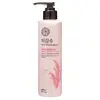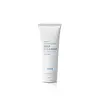What's inside
What's inside
 Key Ingredients
Key Ingredients

 Benefits
Benefits

 Concerns
Concerns

 Ingredients Side-by-side
Ingredients Side-by-side

Water
Skin ConditioningParaffinum Liquidum
EmollientDipropylene Glycol
HumectantIsopropyl Myristate
EmollientDicaprylyl Ether
Emollient1,2-Hexanediol
Skin ConditioningOryza Sativa Extract
AbsorbentOryza Sativa Bran Oil
EmollientSaponaria Officinalis Leaf/Root Extract
Skin ConditioningCetearyl Olivate
Stearic Acid
CleansingSorbitan Olivate
EmulsifyingCaprylic/Capric Glycerides
EmollientPPG-26-Buteth-26
Skin ConditioningAcrylates/C10-30 Alkyl Acrylate Crosspolymer
Emulsion StabilisingPEG-40 Hydrogenated Castor Oil
EmulsifyingLithium Magnesium Sodium Silicate
AbsorbentSodium Cetearyl Sulfate
CleansingCaramel
Cosmetic ColorantPotassium Hydroxide
BufferingDisodium EDTA
Dextrin
AbsorbentButylene Glycol
HumectantTocopherol
AntioxidantPhenoxyethanol
PreservativeParfum
MaskingHexyl Cinnamal
PerfumingWater, Paraffinum Liquidum, Dipropylene Glycol, Isopropyl Myristate, Dicaprylyl Ether, 1,2-Hexanediol, Oryza Sativa Extract, Oryza Sativa Bran Oil, Saponaria Officinalis Leaf/Root Extract, Cetearyl Olivate, Stearic Acid, Sorbitan Olivate, Caprylic/Capric Glycerides, PPG-26-Buteth-26, Acrylates/C10-30 Alkyl Acrylate Crosspolymer, PEG-40 Hydrogenated Castor Oil, Lithium Magnesium Sodium Silicate, Sodium Cetearyl Sulfate, Caramel, Potassium Hydroxide, Disodium EDTA, Dextrin, Butylene Glycol, Tocopherol, Phenoxyethanol, Parfum, Hexyl Cinnamal
Paraffinum Liquidum
EmollientWater
Skin ConditioningPropylene Glycol
HumectantPetrolatum
EmollientIsopropyl Myristate
EmollientPolysorbate 60
EmulsifyingCetyl Alcohol
EmollientGlyceryl Stearate
EmollientPEG-100 Stearate
Caprylic/Capric Triglyceride
Masking1,2-Hexanediol
Skin ConditioningBeeswax
Emulsion StabilisingButylene Glycol
HumectantCamellia Sinensis Leaf Water
MaskingCarbomer
Emulsion StabilisingCentella Asiatica Extract
CleansingCera Alba
EmollientCeramide NP
Skin ConditioningDaucus Carota Sativa Root
Skin ConditioningDaucus Carota Sativa Root Extract
Skin ConditioningDimethicone
EmollientDisodium EDTA
Ethylhexylglycerin
Skin ConditioningFicus Carica Fruit Extract
HumectantGinkgo Biloba Leaf Extract
Skin ConditioningGlycerin
HumectantHydrogenated Lecithin
EmulsifyingMacadamia Integrifolia Seed Oil
Skin ConditioningPanax Ginseng Root Extract
EmollientParfum
MaskingSorbitan Sesquioleate
EmulsifyingSorbitan Stearate
EmulsifyingStearyl Glycyrrhetinate
Skin ConditioningTocopherol
AntioxidantTocopheryl Acetate
AntioxidantTromethamine
BufferingXanthan Gum
EmulsifyingPhenoxyethanol
PreservativeSorbic Acid
PreservativeLinalool
PerfumingParaffinum Liquidum, Water, Propylene Glycol, Petrolatum, Isopropyl Myristate, Polysorbate 60, Cetyl Alcohol, Glyceryl Stearate, PEG-100 Stearate, Caprylic/Capric Triglyceride, 1,2-Hexanediol, Beeswax, Butylene Glycol, Camellia Sinensis Leaf Water, Carbomer, Centella Asiatica Extract, Cera Alba, Ceramide NP, Daucus Carota Sativa Root, Daucus Carota Sativa Root Extract, Dimethicone, Disodium EDTA, Ethylhexylglycerin, Ficus Carica Fruit Extract, Ginkgo Biloba Leaf Extract, Glycerin, Hydrogenated Lecithin, Macadamia Integrifolia Seed Oil, Panax Ginseng Root Extract, Parfum, Sorbitan Sesquioleate, Sorbitan Stearate, Stearyl Glycyrrhetinate, Tocopherol, Tocopheryl Acetate, Tromethamine, Xanthan Gum, Phenoxyethanol, Sorbic Acid, Linalool
Ingredients Explained
These ingredients are found in both products.
Ingredients higher up in an ingredient list are typically present in a larger amount.
1,2-Hexanediol is a synthetic liquid and another multi-functional powerhouse.
It is a:
- Humectant, drawing moisture into the skin
- Emollient, helping to soften skin
- Solvent, dispersing and stabilizing formulas
- Preservative booster, enhancing the antimicrobial activity of other preservatives
Butylene Glycol (or BG) is used within cosmetic products for a few different reasons:
Overall, Butylene Glycol is a safe and well-rounded ingredient that works well with other ingredients.
Though this ingredient works well with most skin types, some people with sensitive skin may experience a reaction such as allergic rashes, closed comedones, or itchiness.
Learn more about Butylene GlycolDisodium EDTA plays a role in making products more stable by aiding other preservatives.
It is a chelating agent, meaning it neutralizes metal ions that may be found in a product.
Disodium EDTA is a salt of edetic acid and is found to be safe in cosmetic ingredients.
Learn more about Disodium EDTAIsopropyl Myristate is an emollient, thickening agent, and texture enhancer. It is created from isopropyl alcohol and myristic acid.
It is used to help other ingredients be better absorbed. It is also an emollient and may help soften and hydrate the skin.
The comedogenic rating of this ingredient depends on the concentration. Lower amounts results in a lower rating.
Isopropyl Myristate may not be fungal acne safe. It can potentially worsen acne prone skin.
Learn more about Isopropyl MyristateParaffinum Liquidum is also known as liquid paraffin. It is a type of highly refined mineral oil.
Like other oils, Paraffinum Liquidum has emollient properties. Emollients help soothe and soften the skin. By creating a barrier to trap moisture within, emollients help keep your skin hydrated.
Paraffinum Liquidum does not irritate the skin and is non-comedogenic.
Learn more about Paraffinum LiquidumParfum is a catch-all term for an ingredient or more that is used to give a scent to products.
Also called "fragrance", this ingredient can be a blend of hundreds of chemicals or plant oils. This means every product with "fragrance" or "parfum" in the ingredients list is a different mixture.
For instance, Habanolide is a proprietary trade name for a specific aroma chemical. When used as a fragrance ingredient in cosmetics, most aroma chemicals fall under the broad labeling category of “FRAGRANCE” or “PARFUM” according to EU and US regulations.
The term 'parfum' or 'fragrance' is not regulated in many countries. In many cases, it is up to the brand to define this term.
For instance, many brands choose to label themselves as "fragrance-free" because they are not using synthetic fragrances. However, their products may still contain ingredients such as essential oils that are considered a fragrance by INCI standards.
One example is Calendula flower extract. Calendula is an essential oil that still imparts a scent or 'fragrance'.
Depending on the blend, the ingredients in the mixture can cause allergies and sensitivities on the skin. Some ingredients that are known EU allergens include linalool and citronellol.
Parfum can also be used to mask or cover an unpleasant scent.
The bottom line is: not all fragrances/parfum/ingredients are created equally. If you are worried about fragrances, we recommend taking a closer look at an ingredient. And of course, we always recommend speaking with a professional.
Learn more about ParfumPhenoxyethanol is a preservative that has germicide, antimicrobial, and aromatic properties. Studies show that phenoxyethanol can prevent microbial growth. By itself, it has a scent that is similar to that of a rose.
It's often used in formulations along with Caprylyl Glycol to preserve the shelf life of products.
Tocopherol (also known as Vitamin E) is a common antioxidant used to help protect the skin from free-radicals and strengthen the skin barrier. It's also fat soluble - this means our skin is great at absorbing it.
Vitamin E also helps keep your natural skin lipids healthy. Your lipid skin barrier naturally consists of lipids, ceramides, and fatty acids. Vitamin E offers extra protection for your skin’s lipid barrier, keeping your skin healthy and nourished.
Another benefit is a bit of UV protection. Vitamin E helps reduce the damage caused by UVB rays. (It should not replace your sunscreen). Combining it with Vitamin C can decrease sunburned cells and hyperpigmentation after UV exposure.
You might have noticed Vitamin E + C often paired together. This is because it is great at stabilizing Vitamin C. Using the two together helps increase the effectiveness of both ingredients.
There are often claims that Vitamin E can reduce/prevent scarring, but these claims haven't been confirmed by scientific research.
Learn more about TocopherolWater. It's the most common cosmetic ingredient of all. You'll usually see it at the top of ingredient lists, meaning that it makes up the largest part of the product.
So why is it so popular? Water most often acts as a solvent - this means that it helps dissolve other ingredients into the formulation.
You'll also recognize water as that liquid we all need to stay alive. If you see this, drink a glass of water. Stay hydrated!
Learn more about Water